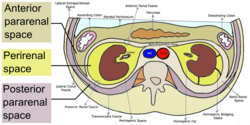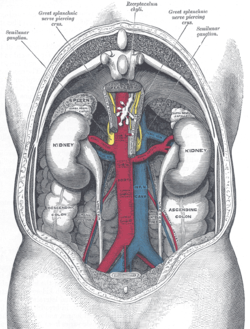Loading AI tools
Anatomical space in the abdominal cavity behind the peritoneum From Wikipedia, the free encyclopedia
The retroperitoneal space (retroperitoneum) is the anatomical space (sometimes a potential space) behind (retro) the peritoneum. It has no specific delineating anatomical structures. Organs are retroperitoneal if they have peritoneum on their anterior side only. Structures that are not suspended by mesentery in the abdominal cavity and that lie between the parietal peritoneum and abdominal wall are classified as retroperitoneal.[1]
| Retroperitoneal space | |
|---|---|
 Horizontal plane through the kidneys, showing subdivisions of the retroperitoneal space. The anterior and posterior pararenal spaces have been exaggerated to provide representation of their relation to other retroperitoneal structures. | |
 Human kidneys viewed from behind with spine removed | |
| Details | |
| Identifiers | |
| Latin | spatium retroperitoneale |
| MeSH | D012187 |
| TA98 | A10.1.01.002 |
| TA2 | 3814 |
| FMA | 15080 |
| Anatomical terminology | |
This is different from organs that are not retroperitoneal, which have peritoneum on their posterior side and are suspended by mesentery in the abdominal cavity.
The retroperitoneum can be further subdivided into the following:[2]
Structures that lie behind the peritoneum are termed "retroperitoneal". Organs that were once suspended within the abdominal cavity by mesentery but migrated posterior to the peritoneum during the course of embryogenesis to become retroperitoneal are considered to be secondarily retroperitoneal organs.


It is also called the perinephric space. Bounded by the anterior and posterior leaves of the renal fascia. It contains the following structures:
Bounded by the posterior layer of peritoneum and the anterior leaf of the renal fascia. It contains the following structures:
Bounded by the posterior leaf of the renal fascia and the muscles of the posterior abdominal wall. It contains only fat ("pararenal fat" also known as "pararenal fat body", "paranephric body", or "paranephric fat").
Pararenal fat is a fatty layer situated posterior to the renal compartment, and extending inferiorly into the iliac fossa.[7] It is situated posterior to the posterior aspect of renal fascia, and anterior to the aponeuroses of the retrorenal muscles. It is plentiful in the dihedral angle of the iliopsoas muscle and the quadratus lumborum muscle, filling the lumbar fossa posterior and inferior to the kidney.[8]
Bleeding from a blood vessel or structure in the retroperitoneal such as the aorta or inferior vena cava into the retroperitoneal space can lead to a retroperitoneal hemorrhage.
It is also possible to have a neoplasm in this area, more commonly a metastasis; or very rarely a primary neoplasm. The most common type is a sarcoma followed by lymphoma, extragonadal germ cell tumor, and gastrointestinal stromal tumor/GIST.[9] Examples of tumors include
Seamless Wikipedia browsing. On steroids.
Every time you click a link to Wikipedia, Wiktionary or Wikiquote in your browser's search results, it will show the modern Wikiwand interface.
Wikiwand extension is a five stars, simple, with minimum permission required to keep your browsing private, safe and transparent.